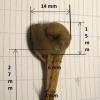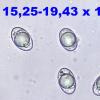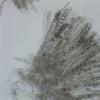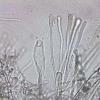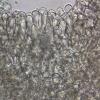
29-12-2025 17:44
Isabelle CharissouBonjour,J'aimerais savoir si d'autres personnes au

29-12-2025 17:12
 Bernard CLESSE
Bernard CLESSE
Bonjour à toutes et tous,Pourriez-vous m'aider à

12-11-2021 00:03
Lepista ZacariasHi everybody,A week ago in my fiels trip I noticed

29-12-2025 17:01
Gernot FriebesHi,I'm looking for help with this hyphomycete with

29-12-2025 08:30
Hello.A tiny ascomycete sprouting under Juniperus

29-12-2025 10:15
Hulda Caroline HolteHello, I found and collected this propoloid ascom

29-12-2025 09:38
Oskari VirtanenHi,could anyone help me identify this, I suspect P

28-12-2025 12:08
Margot en Geert VullingsThis possible Karstenia was found on the bark of d
In the middle of an alder swamp forest, in Belgium, is a dike that the last six months has been inundated by the high water level.
Ascomata was found in November, at the base of a mossy, dead poplar (populus) seemingly growing on the bark.
Apothecium: 14 x 15 mm, saddle-shaped, selliform, grey-green, the brim is not attached to the stipe except one attachment of 0.5 mm wide;
Stalk: dirty yellow, 27 mm long, at the top 6 mm and 4 mm wide at the base, the whole length ribbed, the ribs run 2 mm further on the apothecium;
Spores: elliptical, 15,23-19,43 x 10,36-12,97 µm, Q = 1.53, 1 large drop and several small ones,
Asci: 194,53-261,53 x 16.77-22,17 µm; cylindrical, IKI-;
Paraphyse: septated, filiform, branched and 5 µm wide with up to 8 µm swollen top
Ectal exipulum: textura globulosa-subglobulosa length > 50 µm
Medular exipulum: textura intricate
Could this be Hevella lacunose var. sulcata or is it a H. lacunose that suffered from the wet weather and environmental conditions? Thanks for your help!
Greetings,
François Bartholomeeusen
Thanks for your good suggestion. I have read the description of H. phlebophora in Ascomycete.org and in Coolia 27 (1) but I still have my doubts. The ribs of the stalk continue on the bottom of the cap but they become very soon furrowed. My spore sizes are also slightly larger.
Greetings,
François

